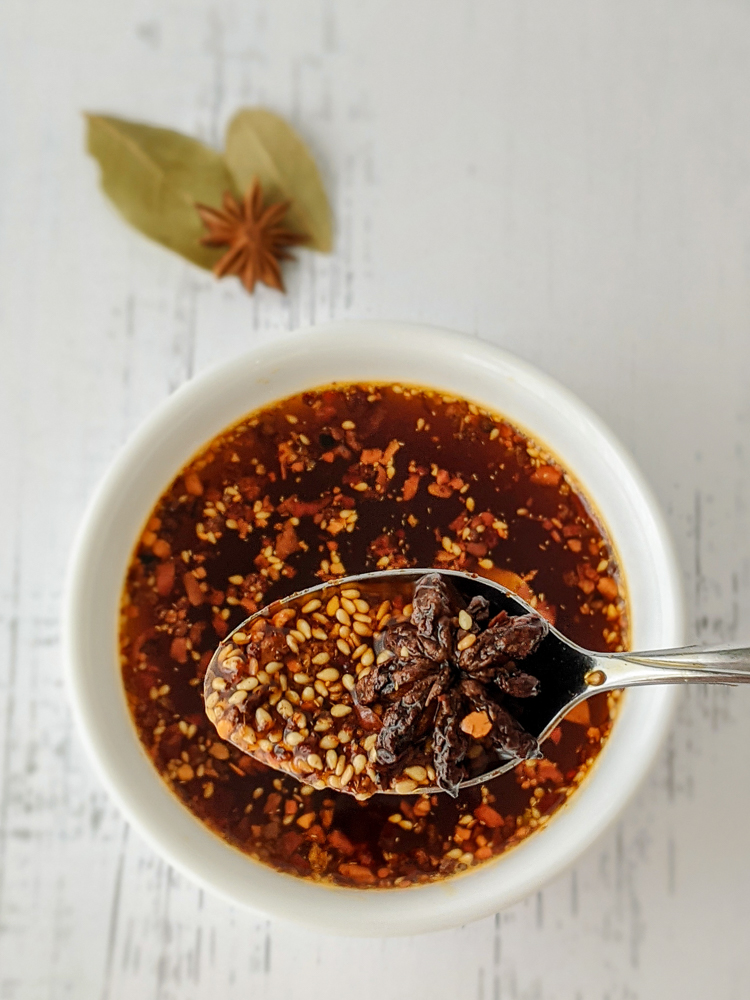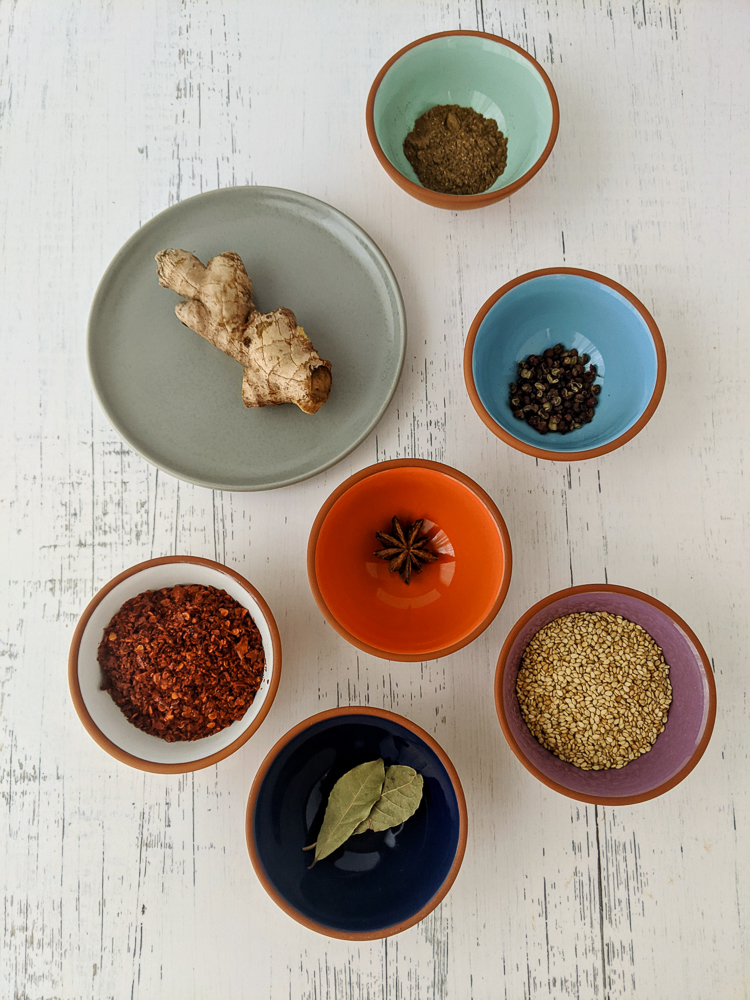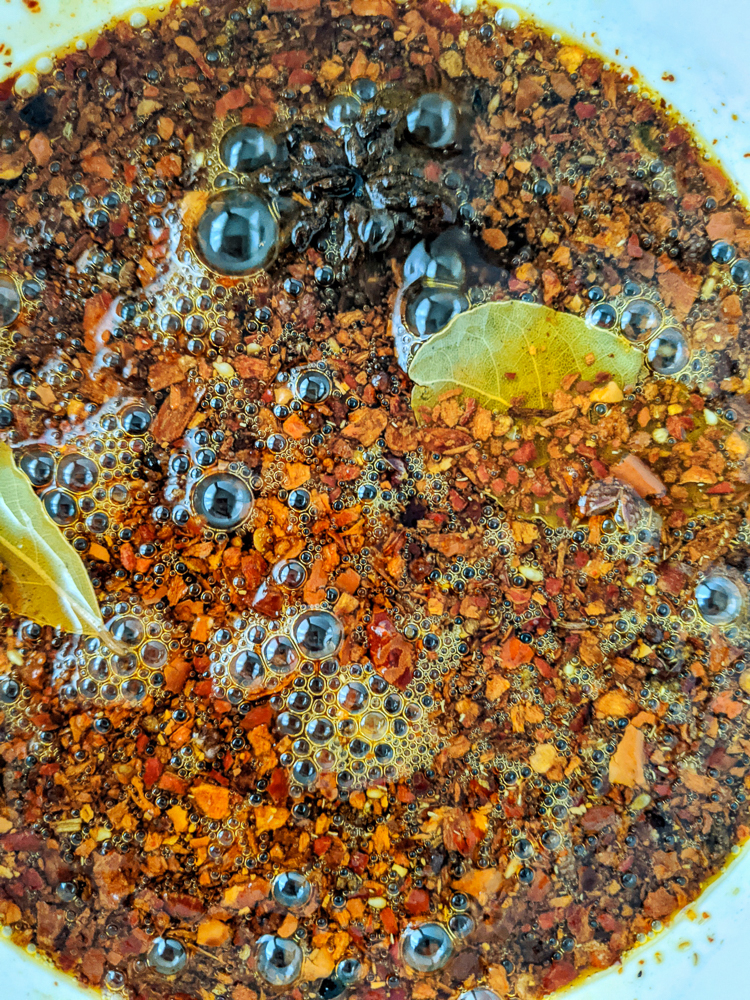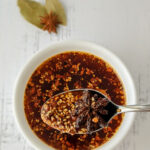Affiliate Disclosure: As an Amazon Associate, I earn from qualifying purchases. Thank you for supporting Bakeroise.

Today I am sharing a naturally vegan Chinese chili oil recipe. Since we’re not going out to eat at our favorite restaurants, even with outdoor seating, I wanted to learn how to make dan dan noodles (dan dan mian) at home. After looking at many different recipes for them, I found what looks to be an amazing vegan one from Maggie at Omnivore’s Cookbook. A vegan recipe from an omnivore? Jackpot! Plus, her stuff looks amazing!
You’re probably wondering why I’m looking at an omnivore’s blog in the first place or why I am inspired by other people’s non-vegan cooking/baking! Well, there are various reasons for this. One of the biggest ones being that I simply want to try and make them as close as I can to the real thing while keeping it in line with my own requirements.
I’ve been vegan for 5 years and I’ve slowly but surely have become quite confident in the kitchen while still being open to learning because that’s really the only way to grow as a cook. So while there are plenty of other vegan recipes around that I use and appreciate, I quite enjoy the process of taking an original recipe and finding a way to make it vegan in my own way. It’s a great way to put what I’ve learned so far to use.
Maggie’s dan dan noodle recipe called for her homemade Chinese chili oil which is naturally vegan. I already had store-bought Chinese chili oil in my kitchen but I thought it’d be fun to make a more “authentic” one from scratch with a specific set of Chinese ingredients.
My dad and favorite aunt love spicy food. They always had different sauces available in our kitchen. I remember how much they loved using so many different types of Asian oils and vinegar in their food and they would also make their own using different types of peppers and garlic.
I’ve made different types of chili oil numerous times in the past with various types of both dried and fresh Asian (and non-Asian) chilis and numerous oils along with just about any kind of onion I could get my hands on. But I’ve never really taken the time to create one from a recipe using specific Chinese ingredients. Since I needed Chinese chili oil for the dan dan mian recipe, why not take the time to learn now?

Maggie made her Chinese chili oil recipe so easy to follow and was generous with the optional ingredients. I wanted to do everything she suggested though so I did not substitute any of the ingredients except for switching out a couple of the conventional ingredients with organic versions which obviously isn’t a big change.
I used whole Sichuan peppercorns while her Chinese chili oil recipe called for ground peppercorns. I was unsure at first because her recipe’s photo showed what looked to be like whole Sichuan peppercorns as opposed to ground peppercorn powder which does exist.
To make the Chinese chili oil, Maggie instructs that the dry ingredients go in a heat-proof ceramic bowl.

I sort of did that. I put it in the ceramic bowl above but worried it wasn’t actually heat proof so I moved them to one of my more reliable Corelle bowls that I know can handle heat. In retrospect I should’ve just used a small pot for ease of handling and certainty.

While the dry ingredients sat in their bowl, I took the piece of ginger and cooked it in vegetable oil in a small pot until it started to shrivel up a little and turn a light brown. I used my cooking thermometer to make sure the heat was at 375°F. So for my own induction stove, that was at medium high heat.
Per Maggie’s instructions, I immediately turned off the heat at that point and carefully poured the hot oil and ginger into the bowl with the dry ingredients and let them cook as I stirred to evenly distribute the oil and flavors. Our Chinese chili oil was starting to come together!

The cooking process was very…pretty. I couldn’t tear my eyes away from the colors brightening as different size bubbles started to appear on the surface. The high contrast of the myriad shades of red, black and orange reminded me of fire which kept me staring so close that I had to remind myself to back up since I’m quite sensitive to the aroma of peppers. They smell so good but if I accidentally inhale them, I just start sneezing. Eek!

Once it stopped bubbling, I continued following the instructions and I removed the star anise, bay leaves and ginger. I let it sit overnight and tried it the next day.
It was heavenly. I love the smoky flavor and slight heat. I’m all about spicy food sometimes but this oil is good in the way that would contribute flavor to a dish without over empowering.

I am happy I took the time to learn how to make this chili oil. This is totally going to be a pantry staple that I won’t mind making over and over again. It’s really that easy and so worth it. Thank you to Maggie for sharing her chili oil recipe on her blog!
Print8-Ingredient Chinese Chili Oil
Perfectly spiced Chinese Chili Oil that has only 8 ingredients – adapted from Omnivore’s Cookbook
- Prep Time: 5
- Cook Time: 5
- Total Time: 10
- Yield: 1 cup 1x
- Method: Frying
- Cuisine: Chinese
- Diet: Vegan
Ingredients
- 4 tablespoons of Chinese chili flakes (not regular ol’ red pepper chili flakes you put on your pizza)
- 2 teaspoons of organic five spice powder
- 3 tablespoons of organic toasted sesame seeds
- 1 teaspoon whole Sichuan peppercorn
- 1 whole star anise
- 2 dried bay leaves
- 1 cup vegetable oil (you may substitute with another neutral oil with high smoke point)
- 1g of fresh, peeled ginger
Instructions
- Combine all the dry ingredients in another small pot that is at least one quart in size.
- In another pot, add the one cup of vegetable oil and the piece of ginger. Adjust heat according to your stove and make sure the oil is about 375°F only.
- Cook only until the ginger starts to wrinkle and turn brown, which is when you turn the heat off immediately.
- Carefully pour the oil and ginger into the pot with the dry ingredients and start to let it cook.
- Gently stir the ingredients with a wooden spoon so they evenly cook in the oil.
- When the chili oil is done bubbling, remove the star anise, ginger and dried bay leaves.
- Let sit in an airtight container overnight so the flavors can marry.
Equipment
 Buy Now →
Buy Now →
Notes
- This recipe is adapted from Omnivore’s Cookbook.
- Store using an airtight container. I like to use a mason jar with a tight lid. According to Maggie, this can be stored for two weeks in room temperature and six months in the fridge.






